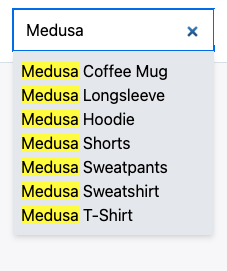Algolia
In this document, you’ll learn how to install the Algolia plugin and use it on both your Medusa backend and your storefront.
Overview
Algolia is a search engine service that allows developers to integrate advanced search functionalities into their websites including typo tolerance, recommended results, and quick responses.
Algolia can be used for a wide range of use cases, including ecommerce websites. By integrating Algolia into your ecommerce website, you can provide your customers with a better user experience and help them find what they’re looking for swifltly.
Through Medusa's flexible plugin system, it is possible to add a search engine to your Medusa backend and storefront using Algolia with just a few steps.
Prerequisites
Medusa Components
It is required to have a Medusa backend installed before starting with this documentation. If not, please follow along with the quickstart guide to get started in minutes.
Furthermore, it’s highly recommended to ensure your Medusa backend is configured to work with Redis. As Medusa uses Redis for the event queue internally, configuring Redis ensures that the search indices in Algolia are updated whenever products on the Medusa backend are updated. You can follow this documentation to install Redis and then configure it on your Medusa backend.
If you don’t install and configure Redis on your Medusa backend, the Algolia integration will still work. However, products indexed in Algolia are only added and updated when you restart the Medusa backend.
Algolia Account
You need to create an Algolia account before you follow this documentation. Algolia offers a free plan to get started quickly.
Create an Algolia App
The first step is to create an Algolia app for your Medusa backend. To create one, open the Applications page or, on your dashboard, go to Settings then choose Applications.
On the Applications page, click on the New application button at the top right.

In the new page that opens, optionally enter a name for the application and choose a subscription plan. You can choose the Free plan for now, but it’s recommended to switch to the Pay-as-you-go plan as your business grows.
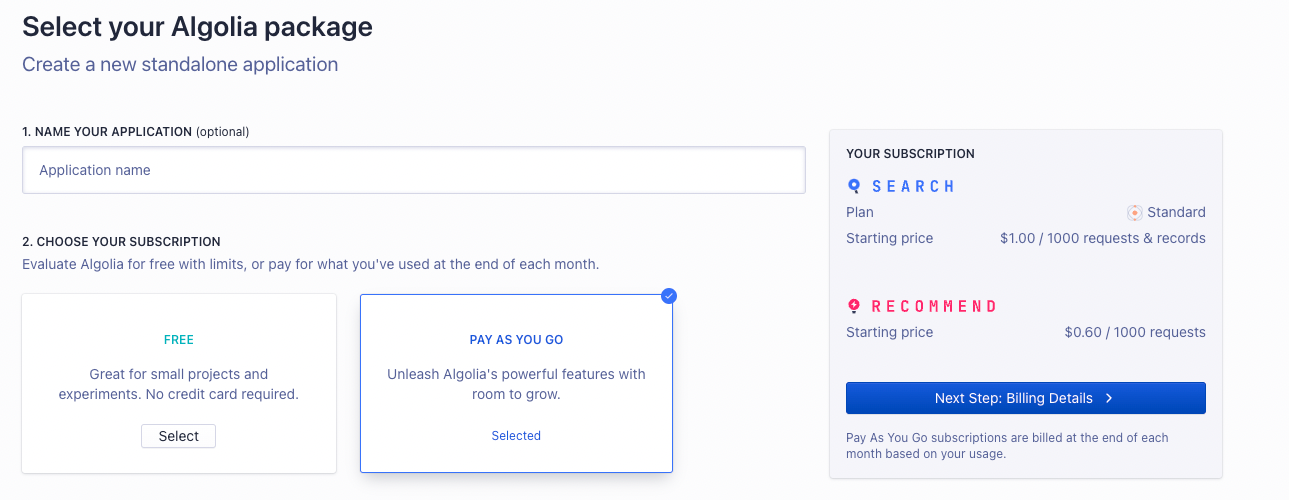
Once you’re done, click on the Next Step button. If you picked Pay as you go service, you’ll need to enter billing details before you proceed.
Then, you’ll be asked to pick a region for your application. Once you’re done, click on Review Application Details.
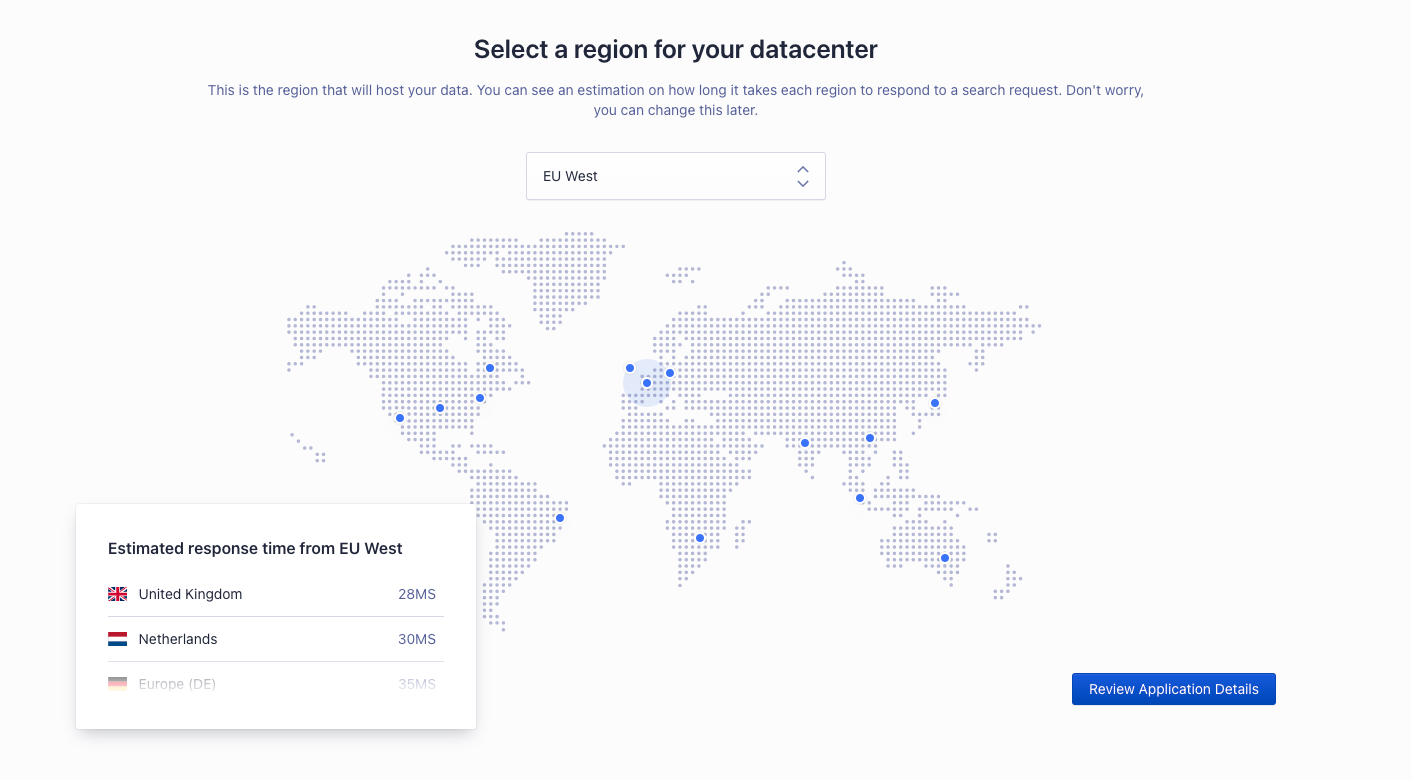
In the last step, you’ll see a summary of your order. If all looks good, check the checkboxes at the end of the form to indicate that you agree to the terms and conditions. Then, click on the Create Application button.
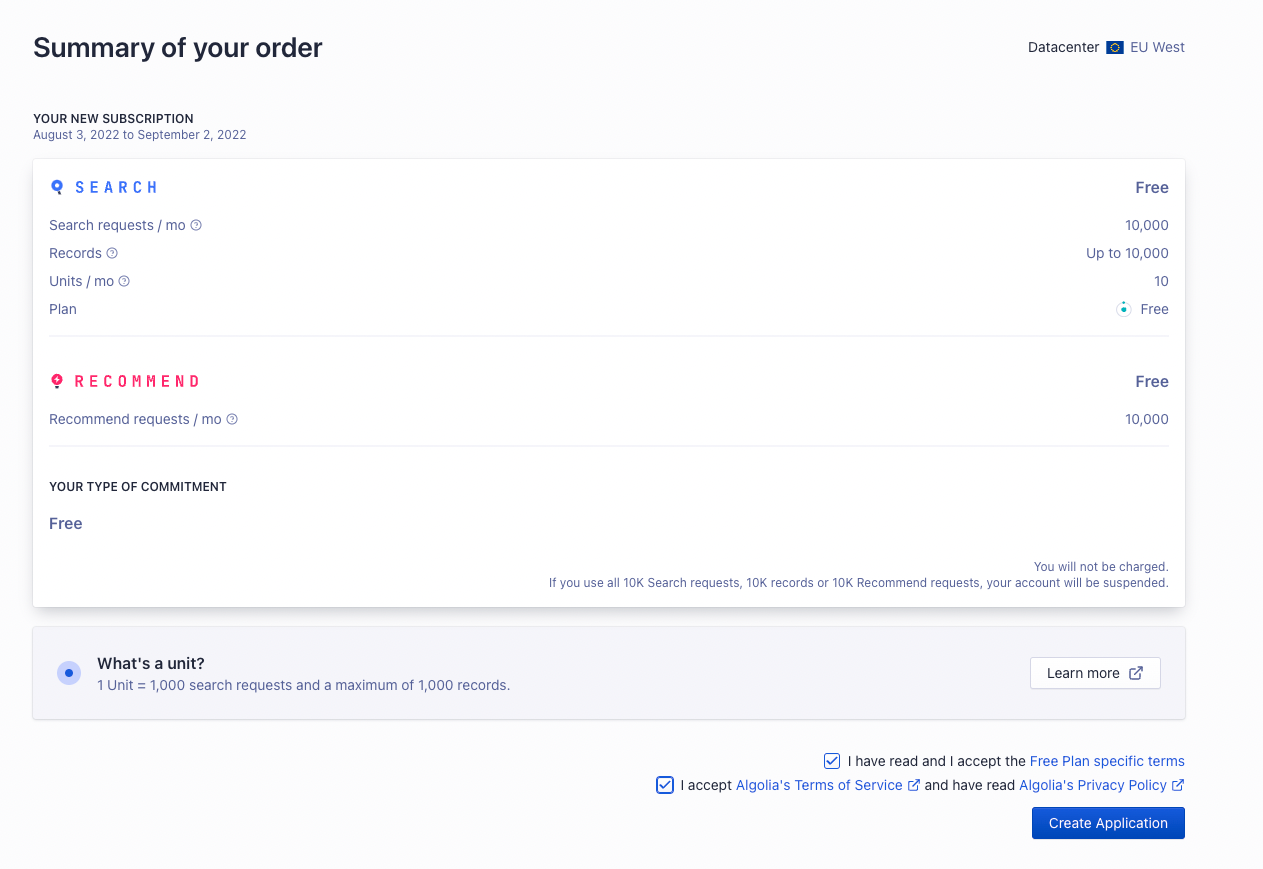
Retrieve API Keys
To retrieve the API keys that you’ll use in the next sections, go to Settings, then choose API Keys in the Team and Access section.
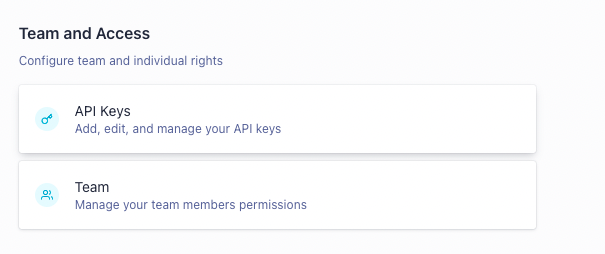
On this page, you’ll find the Application ID, Search-Only API Key, and Admin API Key. You’ll need the Application ID and Admin API Key for the Medusa backend. As for the storefront, you’ll need the Application ID and Search-Only API Key.
If you have more than one application in your Algolia account, make sure you’re viewing the keys of the correct application by checking the Application dropdown at the top left.

Install the Algolia Plugin
In the directory of your Medusa backend, run the following command to install the Algolia plugin:
- npm
- Yarn
npm install medusa-plugin-algolia
yarn add medusa-plugin-algolia
Then, add the following environment variables to your Medusa backend:
ALGOLIA_APP_ID=<YOUR_APP_ID>
ALGOLIA_ADMIN_API_KEY=<YOUR_ADMIN_API_KEY>
Where <YOUR_APP_ID> and <YOUR_ADMIN_API_KEY> are respectively the Application ID and Admin API Key found on the API Keys page.
Finally, in medusa-config.js add the following item into the plugins array:
const plugins = [
// ...
{
resolve: `medusa-plugin-algolia`,
options: {
application_id: process.env.ALGOLIA_APP_ID,
admin_api_key: process.env.ALGOLIA_ADMIN_API_KEY,
settings: {
products: {
searchableAttributes: ["title", "description"],
attributesToRetrieve: [
"id",
"title",
"description",
"handle",
"thumbnail",
"variants",
"variant_sku",
"options",
"collection_title",
"collection_handle",
"images",
],
},
},
},
},
]
The searchableAttributes are the attributes in a product that are searchable, and attributesToRetrieve are the attributes to retrieve for each product result. You’re free to make changes to these attributes as you see fit, but these are the recommended attributes.
Test the Algolia Plugin
Run your Medusa backend with the following command:
- npm
- Yarn
npm run start
yarn run start
The quickest way to test that the integration is working is by sending a POST request to /store/products/search. This endpoint accepts a q body parameter of the query to search for and returns in the result the products that match this query.

You can also check that the products are properly indexed by opening your Algolia dashboard and choosing Search from the left sidebar. You’ll find your products that are on your Medusa backend added there.
If you have more than one application on your Algolia account, make sure you’re viewing the keys of the correct one by checking the Application dropdown at the top left.
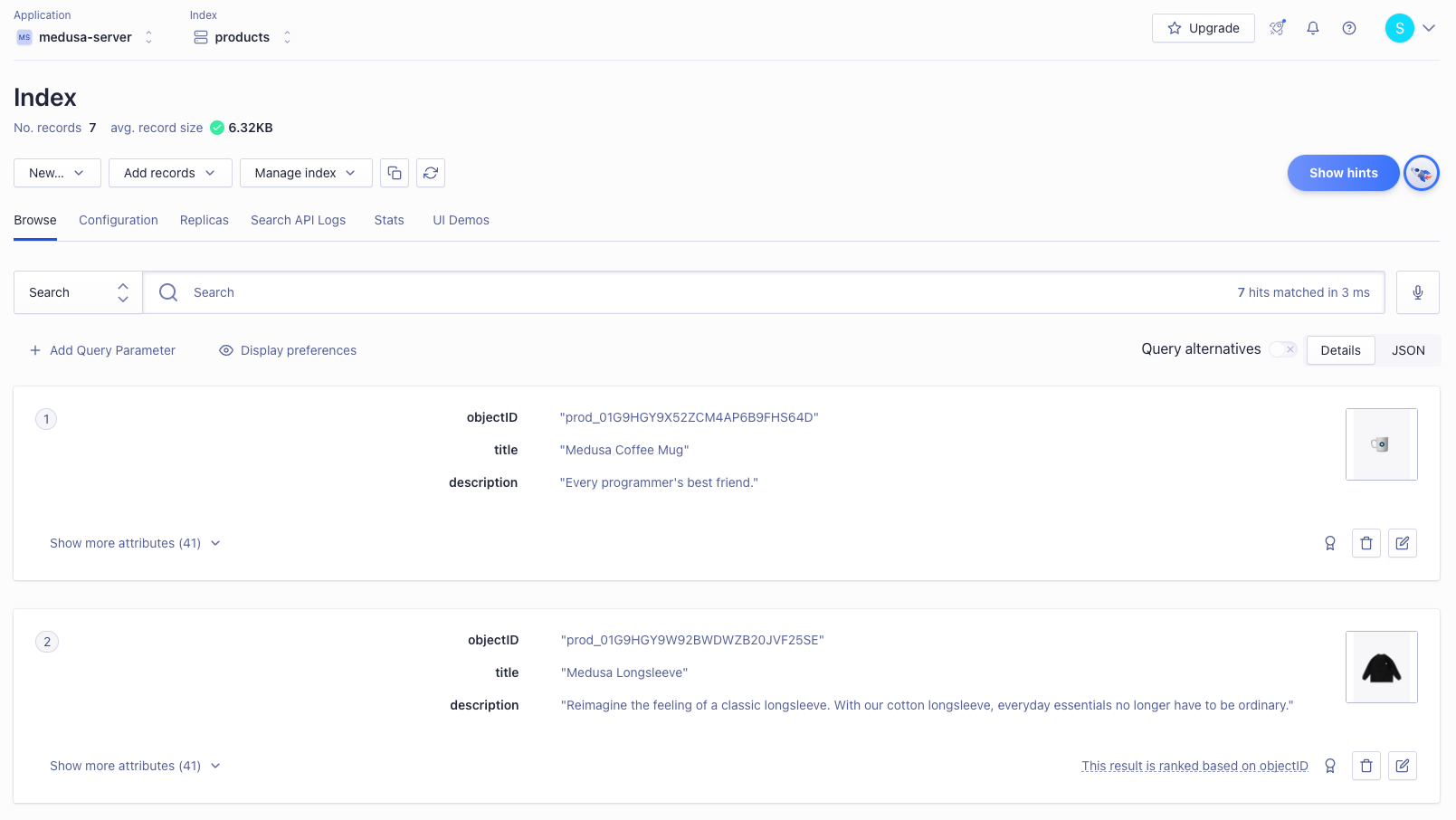
Add or Update Products
If you add or update products on your Medusa backend, the addition or update will be reflected in the Algolia indices.
This feature is only available if you have Redis installed and configured with your Medusa backend as mentioned in the Prerequisites section. Otherwise, you must re-run the Medusa backend to see the change in the Algolia indices.
Add Search to your Storefront
In this section, you’ll learn how to add the UI on your storefront to allow searching with Algolia. This section has instructions for Medusa’s Next.js storefront as well as React-based frameworks.
Storefront Prerequisites
It is assumed you already have a storefront set up and working with the Medusa backend, as this section only covers how to add the search UI.
If you don’t have a storefront set up, you can use the Next.js starter storefront that Medusa provides.
Add to Next.js Storefront
The Next.js storefront has the Algolia integration available out of the box. To get it working, you just need to follow three steps.
First, ensure that the search feature is enabled in store.config.json:
{
"features": {
"search": true
}
}
Then, add the necessary environment variables:
NEXT_PUBLIC_SEARCH_APP_ID=<YOUR_APP_ID>
NEXT_PUBLIC_SEARCH_API_KEY=<YOUR_SEARCH_API_KEY>
NEXT_PUBLIC_SEARCH_INDEX_NAME=products
Where <YOUR_APP_ID> and <YOUR_SEARCH_API_KEY> are respectively the Application ID and Search-Only API Key on the API Keys page.
Finally, change the code in src/lib/search-client.ts to the following:
import algoliasearch from "algoliasearch/lite"
const appId = process.env.NEXT_PUBLIC_SEARCH_APP_ID || ""
const apiKey =
process.env.NEXT_PUBLIC_SEARCH_API_KEY || "test_key"
export const searchClient = algoliasearch(appId, apiKey)
export const SEARCH_INDEX_NAME =
process.env.NEXT_PUBLIC_INDEX_NAME || "products"
If you run your Next.js storefront now while the Medusa backend is running, the search functionality will be available in your storefront.
To make sure the Next.js storefront properly displays the products in the search result, include in the attributesToRetrieve setting of the Algolia plugin on the Medusa backend at least the fields title, handle, description, and thumbnail.
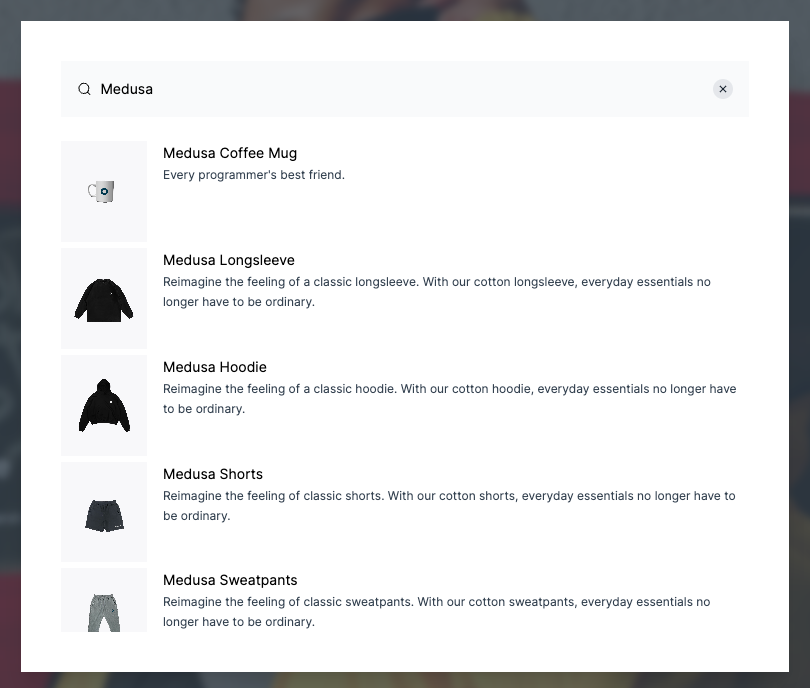
Add to Gatsby and React-Based Storefronts
This section covers adding the search UI to React-based storefronts. It uses the Gatsby storefront as an example, but you can use the same steps on any React-based framework.
For other frontend frameworks, please check out Algolia’s Integrations guide for steps based on your framework.
In the directory that contains your storefront, run the following command to install the necessary dependencies:
- npm
- Yarn
npm install algoliasearch react-instantsearch-dom
yarn add algoliasearch react-instantsearch-dom
Then, add the following environment variables:
GATSBY_ALGOLIA_APP_ID=<YOUR_APP_ID>
GATSBY_ALGOLIA_SEARCH_API_KEY=<YOUR_SEARCH_API_KEY>
GATSBY_SEARCH_INDEX_NAME=products
Where <YOUR_APP_ID> and <YOUR_SEARCH_API_KEY> are respectively the Application ID and Search-Only API Key on the API Keys page.
In Gatsby, environment variables that should be public and available in the browser are prefixed with GATSBY_. If you’re using another React-based framework, you might need to use a different prefix to ensure these variables can be used in your code. Please refer to your framework’s documentation for help on this.
Then, create the file src/components/header/search.jsx with the following content:
import {
Highlight,
Hits,
InstantSearch,
SearchBox,
connectStateResults,
} from "react-instantsearch-dom"
import React from "react"
import algoliasearch from "algoliasearch/lite"
const searchClient = algoliasearch(
process.env.GATSBY_ALGOLIA_APP_ID,
process.env.GATSBY_ALGOLIA_SEARCH_API_KEY
)
const Search = () => {
const Results = connectStateResults(
({ searchState, searchResults, children }) => {
return (
searchState && searchState.query &&
searchResults && searchResults.nbHits !== 0 ?
(
<div
className="absolute ...">
{children}
</div>
) : (
<div></div>
)
)
}
)
return (
<div className="relative">
<InstantSearch
indexName={process.env.GATSBY_SEARCH_INDEX_NAME}
searchClient={searchClient}>
<SearchBox submit={null} reset={null} />
<Results>
<Hits hitComponent={Hit} />
</Results>
</InstantSearch>
</div>
)
}
const Hit = ({ hit }) => {
return (
<div key={hit.id} className="relative">
<div className="hit-name">
<Highlight attribute="title" hit={hit} tagName="mark" />
</div>
</div>
)
}
export default Search
This file uses the dependencies you installed to show the search results. It also initializes Algolia using the environment variables you added.
If you named your environment variables differently based on your framework, make sure to rename them here as well.
Finally, import this file at the beginning of src/components/header/index.jsx:
import Search from "./search"
And add the Search component in the returned JSX before RegionPopover:
// ...
<div className="...">
<Search />
<RegionPopover regions={mockData.regions} />
</div>
// ...
If you run your Gatsby storefront while the Medusa backend is running, you should find a search bar in the header of the page. Try entering a query to search through the products in your store.
